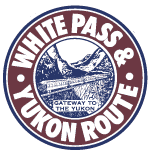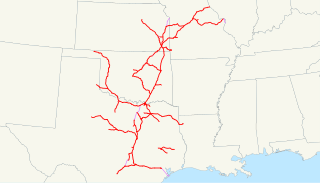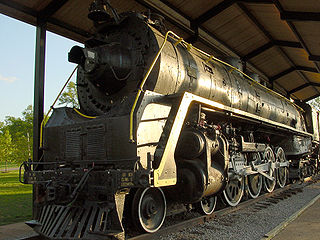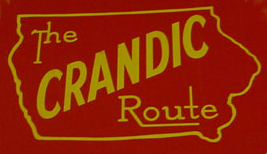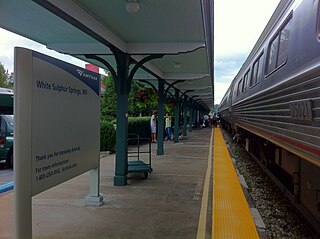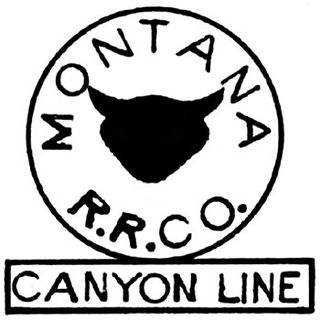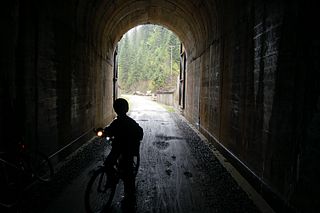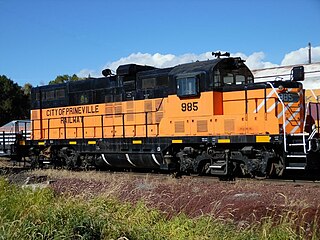The White Sulphur Springs and Yellowstone Park Railway( reporting mark WSYP), now defunct, was an American railroad built and operated between the towns of Ringling and White Sulphur Springs, Montana, a distance of 22.8 miles. The railroad, constructed in 1910, provided White Sulphur Springs with a link to the national railway network via a connection with the Chicago, Milwaukee, St. Paul and Pacific Railroad ("the Milwaukee Road") at Ringling (Formerly Leader, Montana, renamed after John Ringling). The southern four miles of the railroad's route, between Ringling and Dorsey, were leased from the Milwaukee Road.
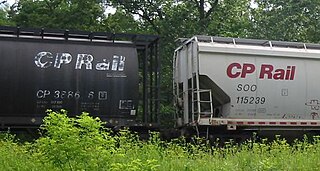
A reporting mark is an alphabetic code of two to four letters used to identify owners or lessees of rolling stock and other equipment used on certain railroad networks.

The United States of America (USA), commonly known as the United States or America, is a country comprising 50 states, a federal district, five major self-governing territories, and various possessions. At 3.8 million square miles, the United States is the world's third or fourth largest country by total area and is slightly smaller than the entire continent of Europe's 3.9 million square miles. With a population of over 327 million people, the U.S. is the third most populous country. The capital is Washington, D.C., and the largest city by population is New York City. Forty-eight states and the capital's federal district are contiguous in North America between Canada and Mexico. The State of Alaska is in the northwest corner of North America, bordered by Canada to the east and across the Bering Strait from Russia to the west. The State of Hawaii is an archipelago in the mid-Pacific Ocean. The U.S. territories are scattered about the Pacific Ocean and the Caribbean Sea, stretching across nine official time zones. The extremely diverse geography, climate, and wildlife of the United States make it one of the world's 17 megadiverse countries.

Ringling is a small unincorporated community in southern Meagher County, Montana, United States, along the route of U.S. Route 89. The town was a station stop on the transcontinental main line of the Chicago, Milwaukee, St. Paul and Pacific Railroad ; it was also the southern terminus of the White Sulphur Springs and Yellowstone Park Railway, which ran from Ringling to White Sulphur Springs. Ringling served as a community center for ranchers and homesteaders in the vicinity, but the town's population declined throughout most of the twentieth century as the region's agricultural activity dwindled. Both railroad lines were abandoned by 1980, and only a handful of people remain in the town today.
Lew Penwell, the promoter and builder of the railroad envisioned that White Sulphur Springs would boom as a tourist center. the Montana daily record reported that $3,000,000 would be spent developing the Smith River valley and build a grand hotel at White Sulphur Springs.
The railroad did a study to extend to Cascade, on the Missouri River, and there were rumors that it might build to Helena, MT, to replace the stagecoach route.
Milwaukee Road had a majority interest in the railroad of 51%, and supplied it with rolling stock and one locomotive. Milwaukee rotated the locomotives that were used on the WSS&YP due to the pure water available at White Sulphur Springs, which removed build-up and scale from the boiler.
WSS&YP employees were expected to do whatever task needed to be done regardless of job description, from selling tickets to shoveling snow.
The railroad was nearly abandoned in 1944, but was saved by George A. Wetherell III and W.C. Ramsey, who bought out the Milwaukee's interest. Business boomed again with the shipping of lumber cut from the nearby mountains.
The railroad was abandoned in 1980, a consequence of the Milwaukee Road abandoning its line through Ringling. The station in White Sulphur Springs still stands after being restored for the movie Heartland in 1982. A heavyweight coach and sleeper sit in front of the station along with a Milwaukee Road ballast car and a stock car, marooned far away from the nearest rail system. An ancient WSS&YP combination car sits in a farmer's field nearby.

Heartland is a 1979 American film, directed by Richard Pearce, starring Rip Torn and Conchata Ferrell. The film is a stark depiction of early homestead life in the American West. It is based on a memoir by Elinore Pruitt Stewart, titled Letters of a Woman Homesteader (1914).
